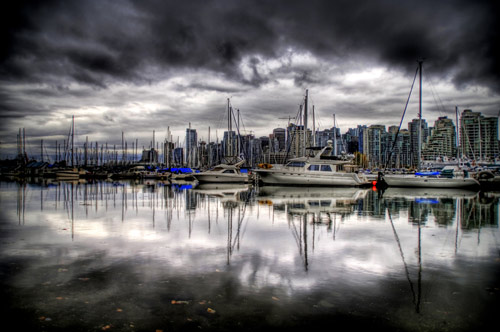Photography podcast #59 talks about HDR (High dynamic range) photography in an interview with fashion photographer and HDR instructor Joseph Cartright. In this podcast we discuss how to create an HDR photograph and be warned, this is an intermediate level podcast. That said, Joseph reviews many of the terms that confuse digital photographers these days, so part of the podcast (especially the beginning) reviews concepts relevant to all digital photography. In a nutshell an HDR image is made of 2 or more shots where the same scene is photographed with bracketed exposures and then put together with software in order to extend the dynamic range (get additional information in the highlights, midtones and shadows) of the scene.
Here’s a few terms as explained by Joseph that are good to absorb right away;
– Latitude — Refers to how much you can be ‘off’ of the correct exposure and still have a usable image.
– Dynamic range — Refers to the usable range of data you can capture between the highlights and the shadows before you lose data. (If you overexpose too much there is no data in the whites or highlights and if you underexpose too much there is no data in the blacks or shadows).
![]()

HDR Image by Trey Ratcliff — Click to enlarge — Original image http://stuckincustoms.com/2008/12/14/my-five-favorites-from-vancouver/
Links mentioned in this podcast and HDR references — Joseph Cartright Photography
Software:
Photomatix — http://www.hdrsoft.com/
FDR tools — http://fdrtools.com/front_e.php
Software overview — http://wiki.panotools.org/HDR_Software_overview
Reference Sites:
http://www.hdrlabs.com/siggraph/
http://www.hdrlabs.com/siggraph/index_files/Witte_HDRI_Tips_Tricks.pdf
http://www.creativepro.com/article/photo-murals-make-you-think-big-really-big
HDR tutorial by Trey Ratcliff
Assignments on the bulletin board:
December photo assignment — The Holidays
December assignment — Photographing words — Winter
Thanks as always to‚ Steven K,‚ Susan, EJC, Dan, JK and aophoto who posted a blog comment about our last podcast. Thanks also to Mark3351, Alex Ross rana, djKianoosh, Rikki, eroder, The_Camera_Poser and benjamindicaprio for joining our bulletin board and posting a few times. We LOVE comments and suggestions so please send more.
If you are looking at this material on any other site except Photography.ca — Please hop on over to the Photography.ca blog and podcast and get this and other photography info directly from the source. I Subscribe with iTunes I Subscribe via RSS feed I Subscribe with Google Reader I Subscribe for free to the Photography podcast — Photography.ca and get all the posts/podcasts by Email
You can download this photography podcast directly by clicking the preceding link or listen to it almost immediately with the embedded player below.
Podcast: Play in new window | Download




very nice pic!
Great podcast, I learned a lot, mainly that I’m not ready to try HDR quite yet. Maybe when I have more time. Even though I won’t be trying it, the technical discussion of dynamic range helped me a lot. I’m going to have to go back and listen to that again.
Excellent podcast. Your guest, Joseph Cartwright provided great insight into the world of HDR.
Hi Marko
That is an excellent podcast. I have been facinated by HDR for long time but didn’t know about the tone mapping. thanks so much for clarrifying that for me.
cheers,
yisehaq
Great podcast. Thank you and please keep up the good work. Your podcast stands out among the crowd.
Hi Marko,
Great podcast! I wanted to mention to others that in some situations you may not have a tripod to take your multiple exposures. But I never let this stop me. Hand-held HDR does work with a little help from photoshop. Photoshop has a cool feature called Auto-Align Layers that you can use to align your exposures before processing through Photomatix. Bring you exposures into Photoshop as separate layers and run Auto-Align Layers. Photoshop does a great job. Then save the individual layers as separate files before processing in Photomatix. You can’t replace the sharpeness you get from using a tripod, but you won’t miss the shot either.
Also Photomatix has a facility to do what’s called pseudo-HDR where it will process a single RAW file and allow you to run the tone-mapping function on your image. This is a great way to experiment with the tone-mapping features in Photomatix.
Have fun!
MikeV
Wonderful podcast!!! I soooooo want to learn how to do this technique! Thanks so much for doing the podcast to both Marko and your guest, Joseph Cartright!
Wow again very informative and I finally figured out what tone mapping is lol I cant wait for more!
and dont worry about mentioning me in the next one lol i fill like i am being too advertased or something (lacking a word there )
but I Do hope to comment on all your future podcast